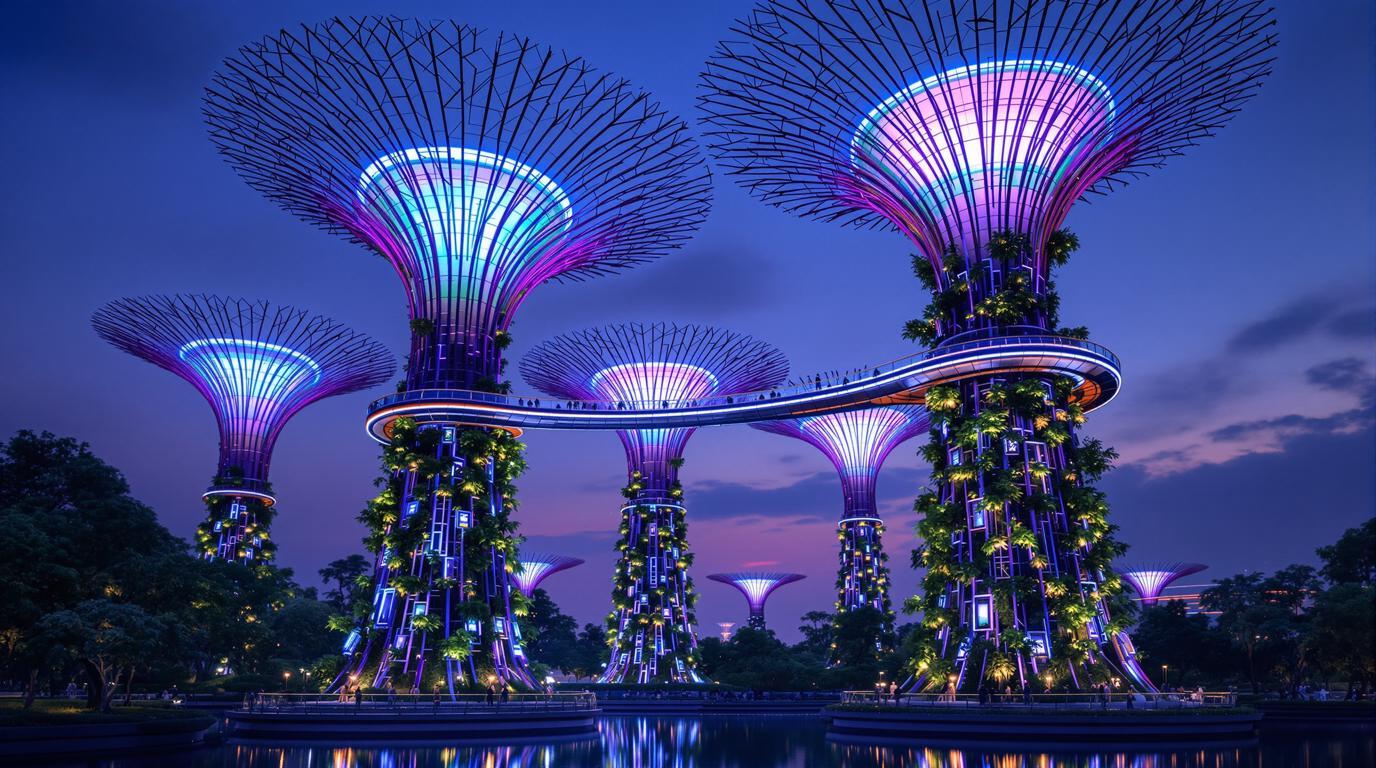Singapore’s futuristic Gardens by the Bay transforms concrete jungle into a botanical wonderland where nature and technology converge in spectacular harmony. This 101-hectare waterfront marvel has welcomed over 50 million visitors since opening in 2012, becoming one of Asia’s most photographed destinations—and for good reason. The garden’s iconic supertrees, soaring conservatories, and innovative sustainability solutions create an otherworldly experience that feels like stepping onto another planet entirely.
Towering giants: The supertree phenomenon
Stretching up to 16 stories high, Gardens by the Bay’s iconic Supertrees aren’t just Instagram bait—they’re vertical gardens housing over 162,900 plants from 200 species. These mechanical marvels harness solar energy to power their nightly light shows while functioning as air vents for the conservatories. The elevated OCBC Skyway connects two Supertrees, offering visitors breathtaking 360° views of Singapore’s urban skyline.
“The Supertrees embody Singapore’s vision of becoming a ‘City in a Garden’—where cutting-edge engineering serves ecological purposes,” explains Dr. Kiat Tan, the garden’s founding CEO.
The world’s largest glass greenhouse
The Flower Dome holds the Guinness World Record as the largest glass greenhouse on Earth. Inside this 1.2-hectare climate-controlled wonder, you’ll journey through nine distinct gardens featuring thousands of plants from Mediterranean regions and semi-arid environments. The dome maintains a perpetual spring-like climate of 23-25°C, creating the perfect environment for plants that would otherwise wilt in Singapore’s tropical heat.
Cloud Forest: Home to the world’s tallest indoor waterfall
Step inside the misty Cloud Forest conservatory and you’re immediately greeted by a thundering 35-meter waterfall cascading down a plant-covered mountain. The cool, moist environment replicates tropical highlands between 1,000-2,000 meters above sea level. Walking along elevated pathways, visitors traverse through mysterious cloud forest vegetation while learning about the threats of climate change to these delicate ecosystems.
The Cloud Forest offers waterfall views that rival natural wonders, creating a misty microclimate within its glass dome.
Supertree Grove after dark: Garden Rhapsody
As night falls, the garden transforms during the mesmerizing Garden Rhapsody light show. The Supertrees come alive with synchronized lights dancing to orchestral music—creating Singapore’s most magical light display. This free nightly spectacle draws crowds at 7:45 and 8:45 PM, offering light shows that rival the northern lights in their splendor.
Heritage Gardens: Cultural storytelling through plants
Beyond futuristic displays, the Heritage Gardens celebrate Singapore’s multicultural roots through plants significant to Chinese, Malay, Indian and Colonial traditions. Here, botanical displays tell the story of Singapore’s diverse cultural landscape and history, with plants that have shaped the island nation’s development over centuries.
The perfect time to visit
Gardens by the Bay welcomes visitors daily from 5:00 AM until 2:00 AM, with the outdoor gardens offering free entry. The conservatories and OCBC Skyway require tickets (approximately $12), with combination passes available. Morning visits offer cooler temperatures, while evenings showcase the gardens’ dramatic lighting.
Like Cappadocia’s fairy chimneys, the Supertrees create an otherworldly landscape that seems to belong to fantasy rather than reality.
Hidden photographic treasures
While most visitors capture the iconic Supertree Grove, photographers seeking unique perspectives should explore Dragonfly Lake at sunrise, when morning mist creates ethereal conditions reminiscent of alpine enrosadira. The Bay East Garden offers the perfect vantage point for capturing the entire garden complex against Singapore’s skyline—especially magical during blue hour.
A sustainable vision realized
Gardens by the Bay exemplifies sustainable design with its closed-loop systems. The Supertrees collect rainwater for irrigation, while biomass from garden waste helps power the cooling systems. This approach has won numerous environmental awards and inspired similar projects in cities worldwide.
“We wanted to create a model for sustainable development that other cities could follow,” says landscape architect Andrew Grant, who helped design the gardens. “Gardens by the Bay demonstrates that urban development can enhance rather than replace nature.”
Like Bamako’s hidden cultural treasures, Gardens by the Bay offers unexpected discoveries at every turn—a place where technology and nature have found perfect harmony in Singapore’s urban heart.
